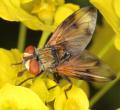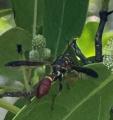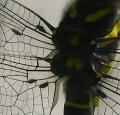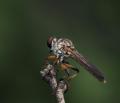Diptera.info :: Identification queries :: Diptera (adults)
Who is here? 1 guest(s)
|
Chloropidae or Agromyzidae in copula
|
|
| pierred |
Posted on 09-11-2023 12:16
|
|
Member Location: Paris (France) Posts: 1448 Joined: 21.04.05 |
Hello, {Click on the picture to get a better resolution. Click again to come back.}  Pierre Duhem : France : Paris : 75018 : 22/10/2023 Altitude : 70 m - Taille : 5-6 mm Réf. : 333439 I could not find a match in the family Agromyzidae (my first choice) and somebody suggested to search in the family Chloropidae, but without result. Can somebody give me an orientation? Thanks in advance. Pierre Duhem |
|
|
|
| eklans |
Posted on 09-11-2023 12:53
|
|
Member Location: Franconia, Germany Posts: 3965 Joined: 11.11.18 |
Hello Pierre, I think Agromyzidae is a good choice - I found copulating Phytomyza krygeri on the flowers of Aquilegia and they resemble yours. Maybe the flower (Crepis?) could help?
Greetings, Eric Kloeckner |
|
|
|
| pierred |
Posted on 09-11-2023 17:09
|
|
Member Location: Paris (France) Posts: 1448 Joined: 21.04.05 |
Thanks. The flower was indeed a Crepis: a bud, not yet opened. Pierre Duhem |
|
|
|
| Barry |
Posted on 09-11-2023 21:06
|
|
Member Location: England Posts: 72 Joined: 20.10.12 |
Phytoliriomyza nigrifrons could be a possibility. This species is only known from female material. See my images of a female on my website; https://agromyzidae.myspecies.info/taxonomy/term/514 If you were to see these again, please do try to collect some and I would be happy to look at them. |
|
|
|
| pierred |
Posted on 10-11-2023 08:14
|
|
Member Location: Paris (France) Posts: 1448 Joined: 21.04.05 |
Thanks also for this proposition.
Pierre Duhem |
|
|
|
| von Tschirnhaus |
Posted on 10-11-2023 19:05
|
|
Member Location: Bielefeld, Germany Posts: 454 Joined: 04.11.07 |
Phytoliriomyza nigrifrons (Hendel, 1920), Agromyzidae. "Barry's" identification is correct. A rare species described from Croatia, known from the Canary Islands, Azores, and UK. One of the few Agromyzidae with distinct sexual colour dimorphism as first time to be seen on the photo. Slightly elongate shape of 3rd antennal segment is typical for many Phytoliriomyza spp. Scutum (=mesonotum) black until edge of scutellum. Male genitalia are not yet figured as males are absent in collections. Further link: https://www.galerie-insecte.org/galerie/view.php?ref=333439 . |
| pierred |
Posted on 11-11-2023 06:46
|
|
Member Location: Paris (France) Posts: 1448 Joined: 21.04.05 |
Thanks a lot.
Pierre Duhem |
|
|
|
| Jump to Forum: |













